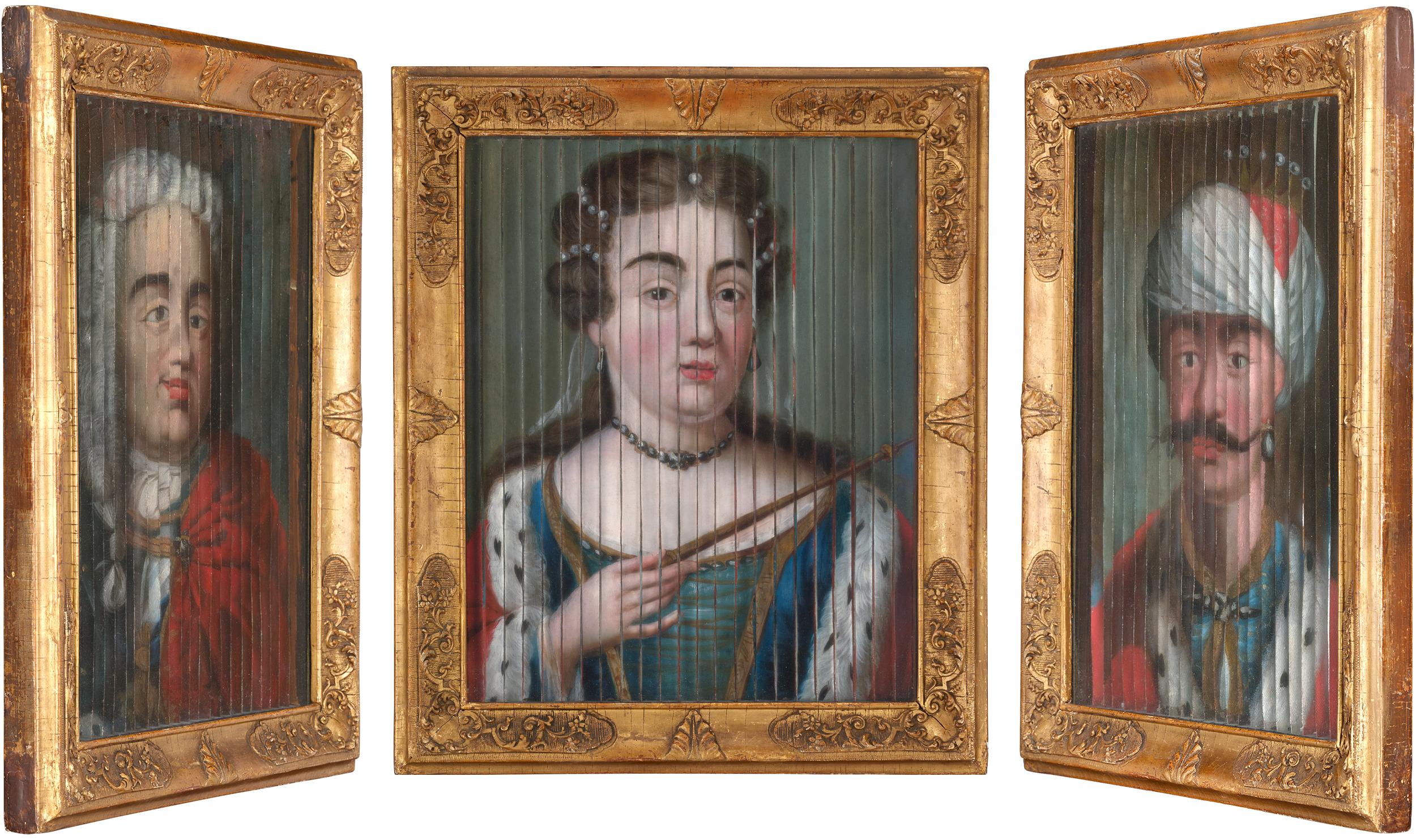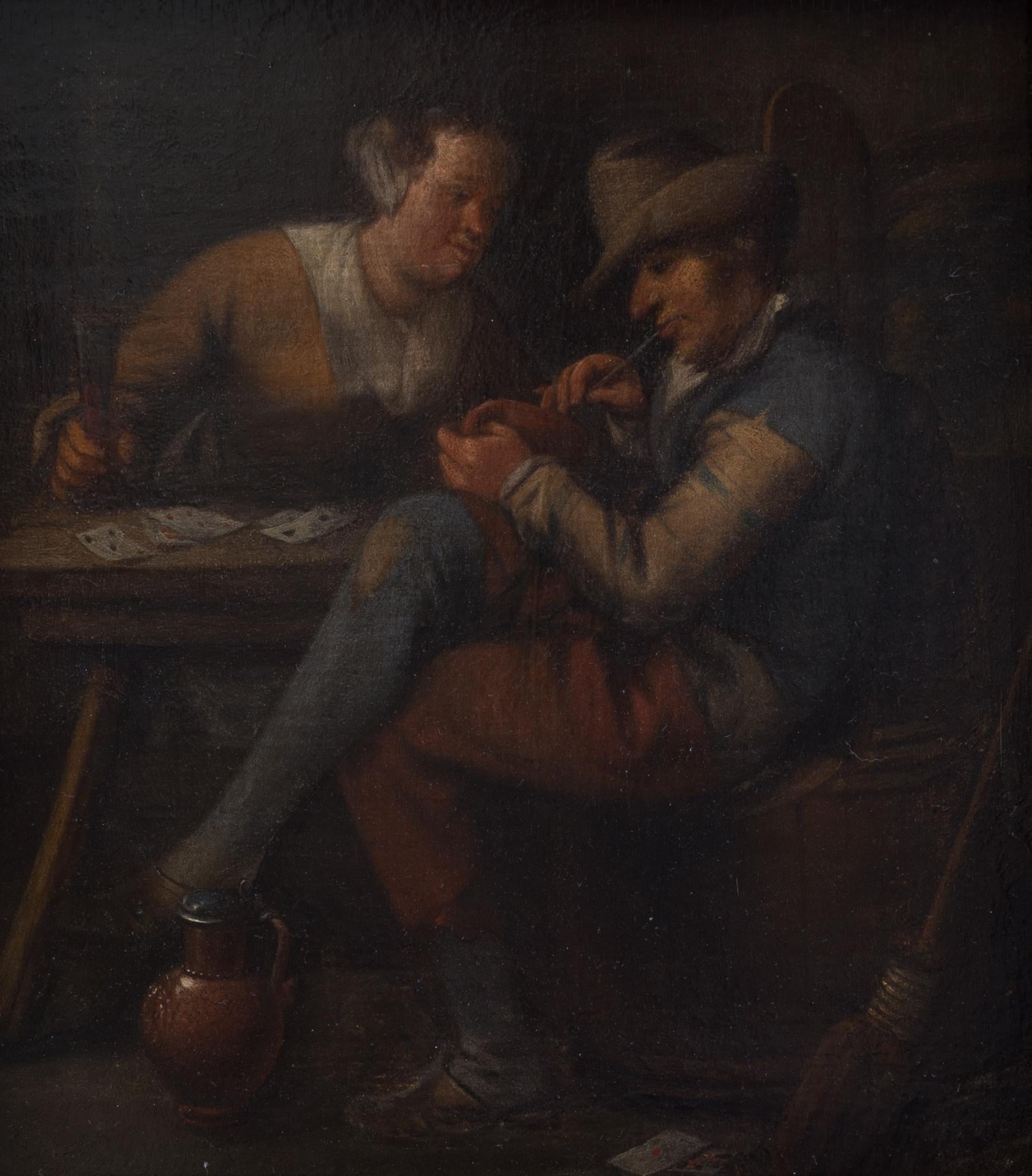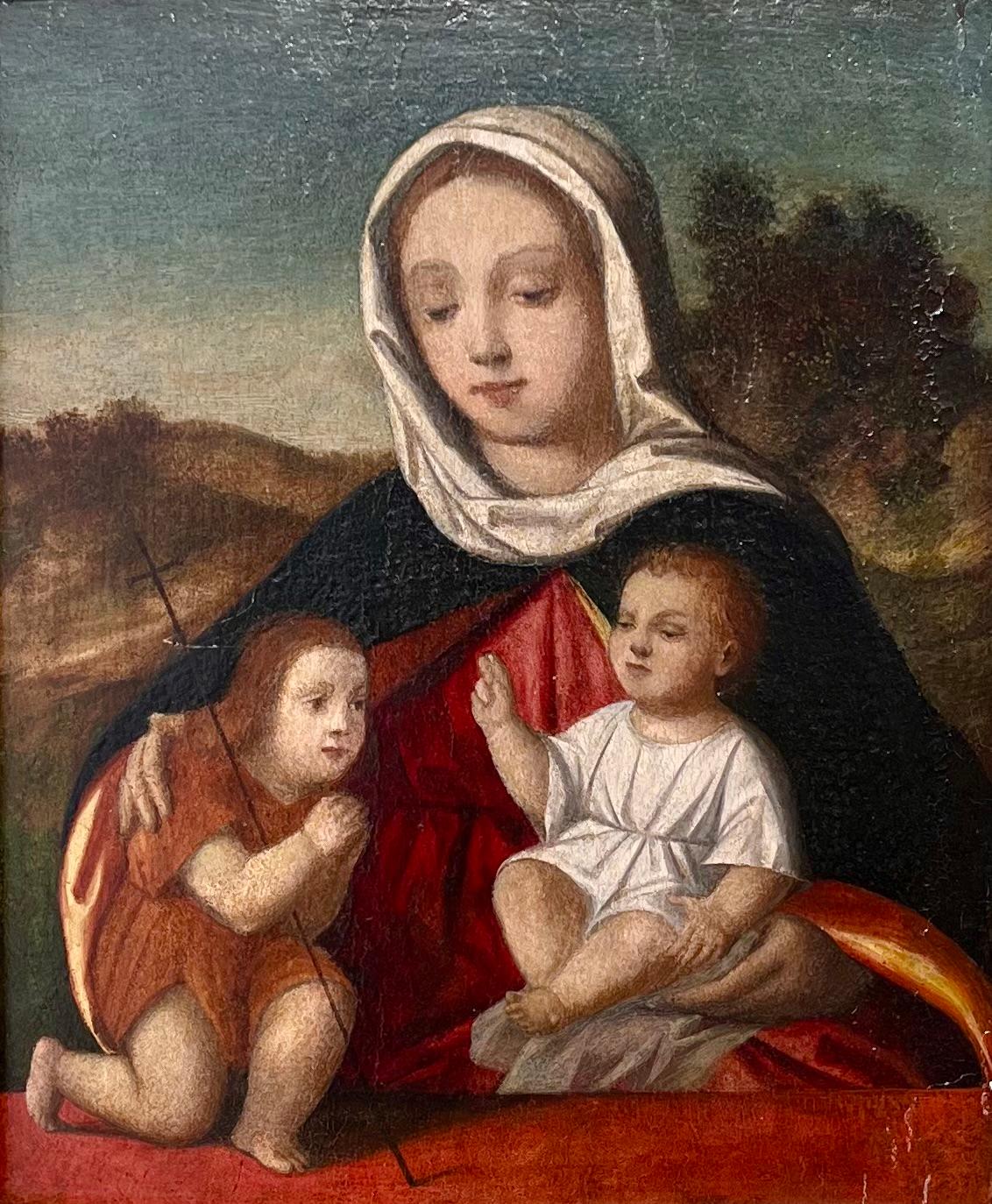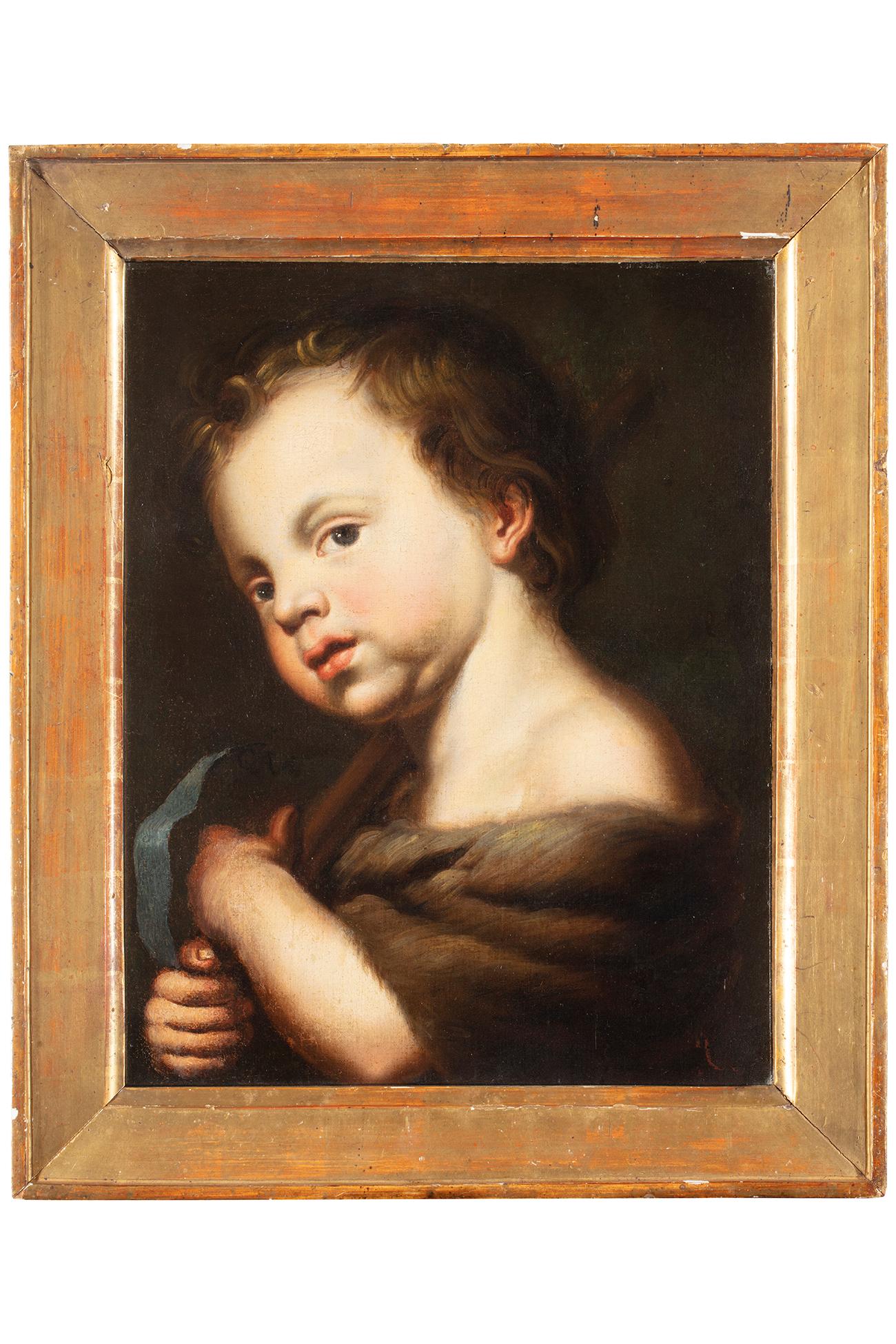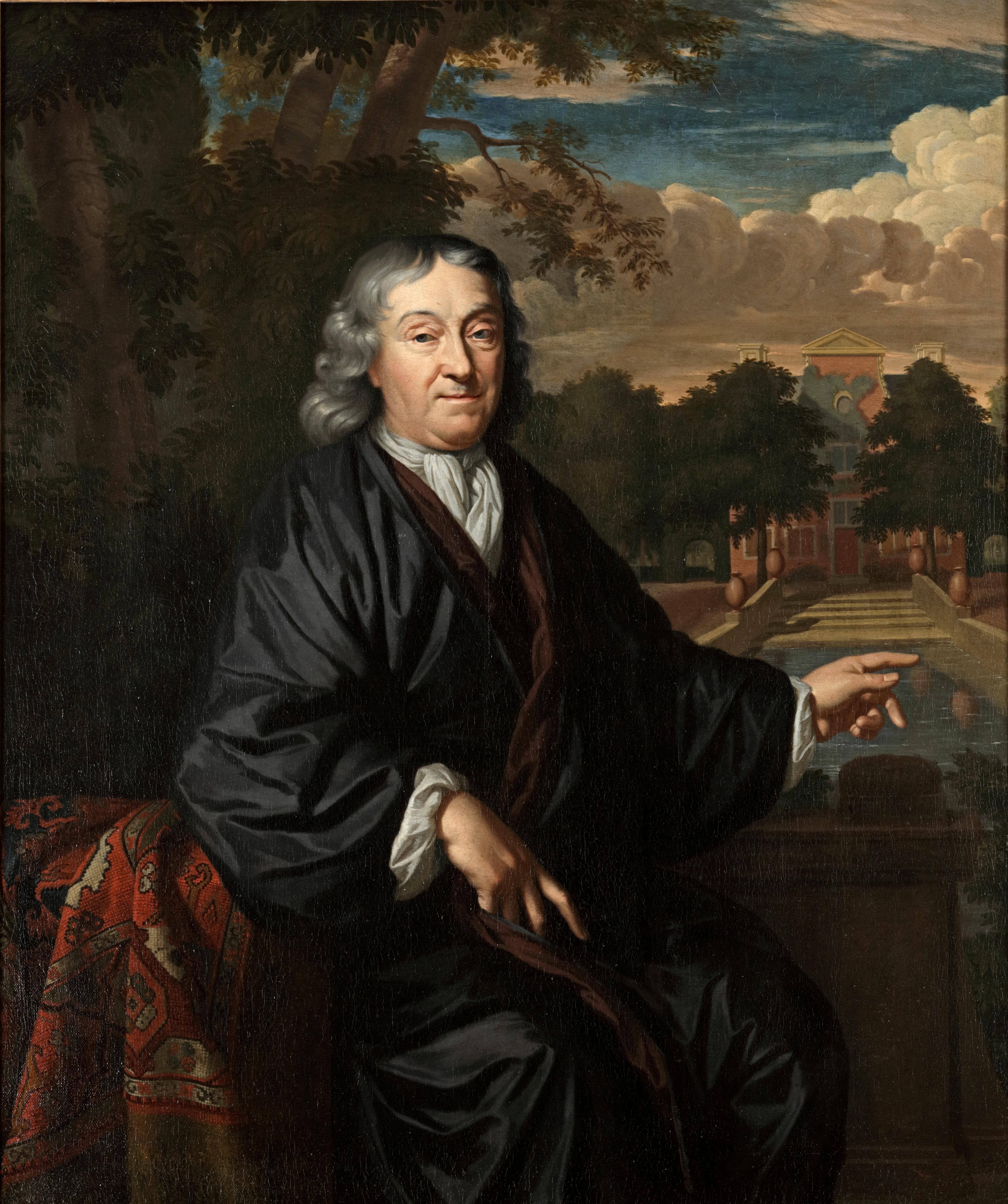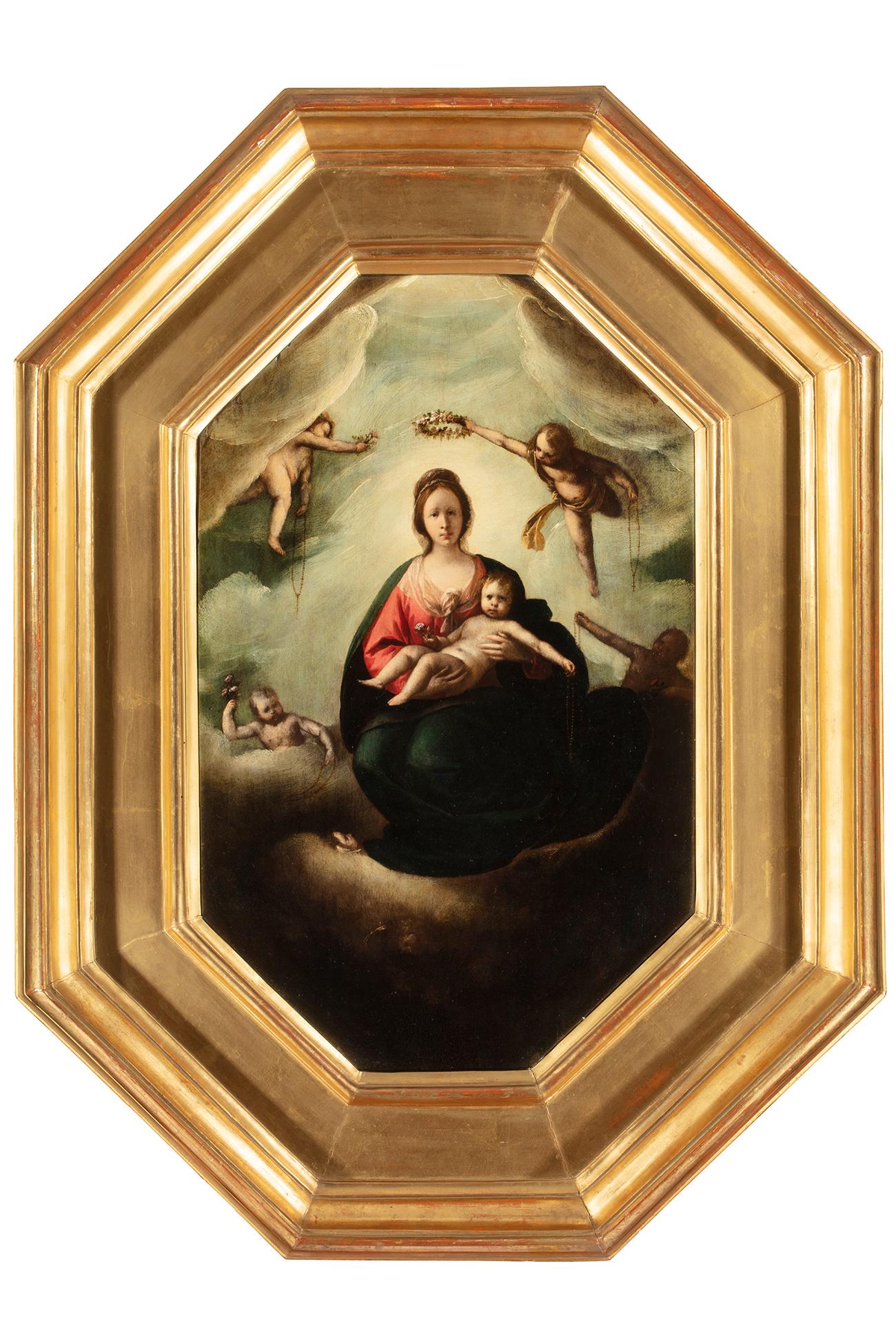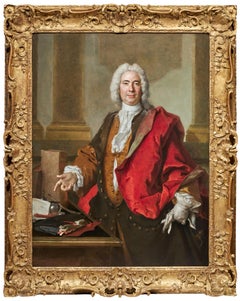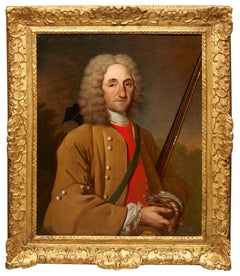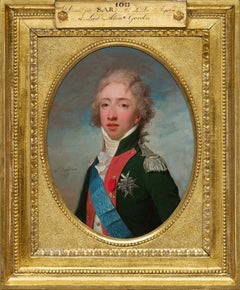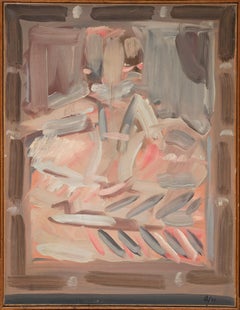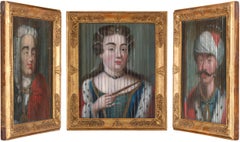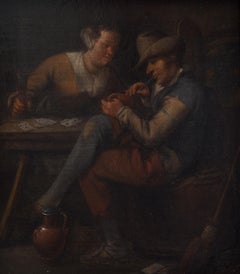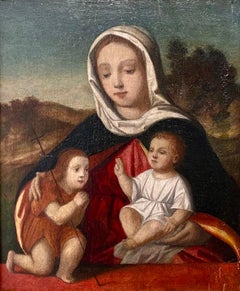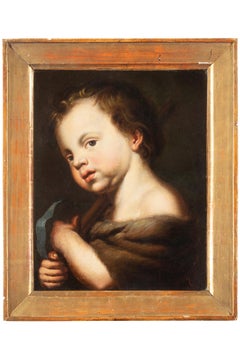Items Similar to Portrait of Senator Bartolomeo Panciatichi by Santi di Tito (1574)
Want more images or videos?
Request additional images or videos from the seller
1 of 13
Santi di TitoPortrait of Senator Bartolomeo Panciatichi by Santi di Tito (1574)1574
1574
About the Item
This recently rediscovered portrait of Santi di Tito depicts a Florentine senator, with a letter in his hand indicating that the painting was executed in 1574 when the sitter was 66 years old. On the basis of these clues, it is tempting to view it as a portrait of Bartolomeo Panciatichi, who was painted some thirty years before by Bronzino (1503 - 1572). While the treatment of the hands recalls the Florentine tradition of Mannerist portraits, the comparison with Bronzino's portrait illustrates Santi di Tito's search for greater realism, despite the stereotyped composition.
1. Santi di Tito, Counter-Reformation painter and portraitist
Santi di Tito was the great painter of the Florentine Counter-Reformation. He proposed a new artistic language that broke away from Mannerism.
Little is known about his training in Florence (perhaps alongside Bronzino or Baccio Bandinelli), but this period of training enabled him to join the Company of Saint Luke, the guild of Florentine painters, in 1554. Between 1560 and 1564, Santi di Tito spent time in Rome, where he frequented the workshop of Taddeo Zuccari. This stay had a fundamental influence on his work, thanks to the discovery of the late work of Raphael, but also his encounters with the painters Francesco Salviati and Federico Barocci.
Around 1565, Santi di Tito returned to Florence, where he remained until the end of his life, dividing his talents between the creation of important religious paintings and countless portraits. He became one of the city's leading painters, distinguishing himself, in particular, in the creation of large religious compositions in which the spirit of the Counter-Reformation was reflected.
In 1568, Santi di Tito became a member of the Confraternity of Saint Thomas Aquinas, whose members were faithful observers of the principles developed during the Council of Trent. Around 1574 (the year of our portrait) he produced one of his masterpieces, The Resurrection, for the Basilica of Santa Croce in Florence in which he departed from previous Florentine works by offering a representation close to the sacred texts, free of any lascivious or purely ornamental elements.
His style, marked by the Florentine preference for drawing, continued to evolve towards a luminous and naturalistic painting that inspired the painters of the following generation.
2. Santi di Tito as a portraitist
Despite, or perhaps because of, the scale of his production and unlike his religious paintings, Santi di Tito's portraits have not been the subject of a monographic study to date. It has been established that Santi di Tito ran an extremely active workshop in the production of portraits, benefiting both from Medici commissions and those of the great Florentine families. The inventory of Santi di Tito's possessions, drawn up after his death on 5 November 1603 , includes a long list of portraits that testify to the importance of this activity.
This multiplication of the portrait in the second half of the 16th century reflects the political evolution of Florence in which Cosimo 1er (who died in 1574, the year of our portrait) established a court with a hierarchical organisation. Florentine society was transformed from a republican and bourgeois society into an aristocratic one, in which the great families imitated the Medici grand-ducal family and commissioned numerous portraits, often intended to constitute galleries of ancestors.
One of the characteristics of Santi di Tito's portraits is the psychological description of the characters, beyond the illustration of social status through the choice of clothes and objects represented. Two other portraits of senators by Santi di Tito are known, demonstrating the Florentine interest in these ceremonial portraits.
3. Description of the portrait
Our senator is depicted in a three-quarter view, in an architectural setting that could be his study. He is dressed in the ceremonial garb of the Florentine senators: a midnight blue jacket covered by a chasuble with red piping, consisting of a transparent gauze in front and a fabric of the same colour as the jacket, lined with a red cloth, in the back. The treatment of the transparent gauze is of great fluidity. Through the undulations he gives to the chasuble, the painter manages to translate the life that animates this imposing body.
Our senator holds a folded letter in his right hand his wrist resting on a table draped in green cloth, while in his left hand he has a pair of gloves. Two other objects are on the table to his right: a book with ornate edges, whose delicate clasp can be seen, and on which rests a quadrangular beret.
As is often the case with similar letters, it provides us with some background information on this painting. Although the name of the model is not given, we know from the inscription "annus aetatis suae 66 - PAD 1574" that he is a 66-year-old man, depicted in 1574. Our attention is drawn to his imperious gaze; the photograph makes his face even more imposing, as it is slightly elongated so that it can be seen without distortion from below.
This portrait strikes a balance between imitation (imitare) and portraiture (ritrarre). The great physical presence of the model evoked by his imposing stature, the accuracy of the proportions and the naturalistic touch of the rendering of the beard establishes a balance with the symbolic significance of the garment (which clearly indicates the model's function), and of the only element of decoration (a book placed on the table, which could be a bible or a book of prayer).
4. Stylistic analysis
While several elements link this portrait to the Florentine pictorial tradition developed by the Mannerist artists, the more naturalistic rendering of the face demonstrates Santi di Tito's stylistic evolution.
The ideal space in which our character is represented is very modern, full of clarity and perfect simplicity, with a certain sophistication. Beyond a foreground delimited by a pillar on the right is a concave space which encloses our character. This architectural space follows the Florentine tradition developed during the sixteenth century, according to which portraits stand out against an architectural background, and no longer against a landscape (as, for example, in the portrait of Bartolomeo Panciatichi by Bronzino, which we will present later).
The very refined treatment of the hands links our painting to the Mannerist tradition, and in particular to the art of Bronzino or Allori, as illustrated by comparing the right hand of our senator with the left hand of the young man portrayed around 1560 by Alessandro Allori:
The position of our senator, with his left arm slightly bent along his body and his right hand resting on the table, is the prototype of a composition that Santi di Tito would repeat many times for official portraits, such as those made in 1589 for Christine of Lorraine, on the occasion of her marriage to Ferdinando I, or the one of Marie de Medici, made at the very end of the 16th century, before her departure for the French throne.
One last detail is interesting because it reveals the evolution of Santi di Tito's style towards naturalism - and thus his move away from mannerism. The treatment of our senator's beard, at once very elaborate and very free, is close to that of one of Guido Guardi's two sons, in a famous portrait of Santi di Tito with the three men, probably completed in the 1570s-1580s.
5. Proposed identification of the model
In 1722, Giuseppe Manni published a collection entitled Serie de' senatori fiorentini, which gives the main chronological references of all the members of the Senate of the Forty-Eight since the creation of this institution in 1532.
Only three senators meet the conditions and could fit as sitter for our portrait: they must be born between 1507 and 1508, to be 66 years old in 1574. The first is Bartolomeo Panciatichi, born on 21 June 1507 and deceased on 23 October 1582. The other was Giovanni Ugolini, born on 11 May 1508 and deceased on 18 August 1588. Elected senator in 1540, he was commissioner of Cortona and appointed ambassador to His Holiness Pope Gregory XIII in 1572, which seems to exclude the painting of his portrait by Santi di Tito in Florence in 1574. As for Simone Corsi (8 December 1508 - 31 March 1587, elected senator in 1556), his birthday seems too close to the end of the year to allow the delivery of his portrait in 1574.
The Bartolomeo Panciatichi hypothesis seems the most interesting to us, especially since around 1545 he posed for a famous portrait by Bronzino (last picture in the gallery) in which we find a number of common characteristic features.
While it is always difficult to recognise a friend in a photo taken thirty years earlier, it is certainly even more difficult to recognise a stranger, portrayed by two different painters thirty years apart.
However, we recognise the shape of the nose, the rather high cheekbones, the finely arched eyebrows and the same position of the ear in both portraits, despite the difference in the pose, which is more frontal with Bronzino. We also find the same bifid beard, whitened by time.
It is questionable whether the elegant hat in Bronzino's portrait is not a cover for incipient baldness. The beret placed on the table thirty years later could then be interpreted as another naturalistic element, the model accepting himself as he is and agreeing to give an image as close as possible to physical reality.
Finally, it is interesting to compare the two expressions, and the evolution between the distanced and questioning gaze of the young man portrayed by Bronzino and the intense and slightly distressed gaze of the elderly man painted by Santi di Tito.
6. Some biographical information on Bartolomeo Panciatichi
Born on 21 June 1507 in Lyons, where his father had commercial interests, the young Bartolomeo entered the court of Francis I as a page. His ties with France were destined to last, as Cosimo I later appointed Bartolomeo as ambassador on diplomatic missions to the king he had once served, and then to Henry II.
Bartolomeo studied in Padua between 1529 and 1531, then in Lyons, where he came into contact with French reformist circles. In 1534, Bartolomeo married Lucrezia di Gismondo Pucci and the couple moved to Lyons, not returning to Florence until the late 1530s. Travel between Florence and France is documented in 1539, 1547, 1549 and 1552, but was undoubtedly more frequent. The Panciatichi couple's interest in the doctrines of the Reformation led to their being tried for Lutheran heresy in 1552 and having to publicly recant. They adhered to strict Catholic orthodoxy after their abjuration.
Bartolomeo Panciatichi developed fairly close contacts with the literary world, not limited to Florence, as evidenced by his friendship with Pietro Aretino based in Venice. Known to his contemporaries mainly as a Latin poet, Bartolomeo joined the Accademia degli Umidi on 2 January 1541, a few weeks before Bronzino, and shortly before the group became the Accademia Fiorentina. His portrait is part of a group of five paintings commissioned by Bartolomeo from Bronzino between 1540 and 1545: three religious scenes, two Holy Families and a Crucified Christ inspired by reformist ideas, and two portraits of him and his wife.
Appointed senator in 1567, Bartolomeo Panciatichi pursued a political career thereafter, becoming commissioner of Pistoia in 1568 and of Pisa in 1578.
The choice of a book as the only accessory in his portrait by Santi di Tito is doubly moving: it obviously evokes the intellectual, but the presence of clasps on the sides indicates that it is probably more of a religious book and testifies to his deep Christian faith.
The majesty of this portrait is enhanced by its framing in a beautiful late 16th century gilded wood cassetta frame which is probably its original frame.
The identification of the sitter of this portrait as Bartolomeo Panciatichi opens a fascinating field of analysis. While it is quite exceptional to have two portraits of a Renaissance man painted within 30 years of each other, Santi di Tito's path, moving away from the seductions of mannerism towards more realistic images, follows the personal evolution of the model. From the haughty and seductive appearance of a man in his thirties he becomes an elderly man, who displays his full humanity in front of us, despite his political power.
Main bibliographical references :
Giuseppe Manni Serie de' senatori fiorentini - 1722 Florence
Carlo Falciani and Antonio Natali Bronzino. Artist and Poet at the Court of the Medici - 2010 Mandragora
Carlo Falciani and Antonio Natali -The Cinquecento in Florence - "Modern Manner" and Counter-Reformation - 2017 Mandragora
Keith Christiansen and Carlo Falciani - The Medici Portraits and Politics 1512 -1570 - 2021 The Metropolitan Museum of Art - New York
- Creator:Santi di Tito (1536 - 1603, Italian)
- Creation Year:1574
- Dimensions:Height: 51.19 in (130.03 cm)Width: 41.33 in (104.98 cm)
- Medium:Poplar,Oil
- Movement & Style:
- Period:
- Condition:43 ½ ‘’x 33 2/3 ‘’ (110.5 x 85.5 cm). Framed : 51 3/16 ‘’x 41 1/3 ‘’(130 x 105 cm) Late 16th century Tuscan carved and gilded wood cassetta frame (probably its original frame) CR available upon request.
- Gallery Location:PARIS, FR
- Reference Number:1stDibs: LU1568211731372
About the Seller
5.0
Vetted Professional Seller
Every seller passes strict standards for authenticity and reliability
Established in 2020
1stDibs seller since 2021
9 sales on 1stDibs
- ShippingRetrieving quote...Shipping from: PARIS, France
- Return Policy
Authenticity Guarantee
In the unlikely event there’s an issue with an item’s authenticity, contact us within 1 year for a full refund. DetailsMoney-Back Guarantee
If your item is not as described, is damaged in transit, or does not arrive, contact us within 7 days for a full refund. Details24-Hour Cancellation
You have a 24-hour grace period in which to reconsider your purchase, with no questions asked.Vetted Professional Sellers
Our world-class sellers must adhere to strict standards for service and quality, maintaining the integrity of our listings.Price-Match Guarantee
If you find that a seller listed the same item for a lower price elsewhere, we’ll match it.Trusted Global Delivery
Our best-in-class carrier network provides specialized shipping options worldwide, including custom delivery.More From This Seller
View AllPortrait of Monsieur Aubert, a ceremonial portrait by Nicolas de Largillière
By Nicolas de Largillière
Located in PARIS, FR
Provenance :
Arnold S. Kirkeby (1901-1962)
Donated by Arnold S. Kirkeby to the Los Angeles County Museum of Art in 1955, where it remained until its sale at Sotheby's, New York on Ja...
Category
1720s Old Masters Portrait Paintings
Materials
Oil
Portrait of Julien Prieur the bailiff of the Marquis d'Armentières as a Hunter
By Jean-Baptiste Oudry
Located in PARIS, FR
This portrait depicts us the trusted confidant of the Conflans d'Armentières family. More precisely, Julien Prieur was the fiscal procurator of the Marquisate of Armentières, playing...
Category
1730s Old Masters Portrait Paintings
Materials
Canvas, Oil
Two royal portraits (the Duc d'Angoulême and the Duc de Berry) by H.P. Danloux
Located in PARIS, FR
These two royal portraits are a major historical testimony to the stay of the Comte d'Artois (the future Charles X) and his family in Edinburgh in 1796-1797. Given by the sitters to Lord Adam Gordon, the Governor of Edinburgh, and kept by family descent to this day, these two portraits provide us with a vivid and spontaneous image of the Duc d’Angoulême and his brother the Duc de Berry. Danloux, who had emigrated to London a few years before, demonstrate his full assimilation of the art of British portrait painters in the brilliant execution of these portraits.
1. Henri-Pierre Danloux, a portraitist in the revolutionary turmoil
Born in Paris in 1753, Henri-Pierre Danloux was first a pupil of the painter Nicolas-Bernard Lépicié (1735 - 1784) and then, in 1773, of Joseph-Marie Vien (1716 - 1809), whom he followed to Rome when, at the end of 1775, Vien became Director of the Académie de France. In Rome he became friends with the painter Jacques-Louis David (1748 - 1825).
Returning to France around 1782, he settled in Lyon for a few years before returning to Paris in 1785. One of his first portraits was commissioned by the Baroness d'Etigny, the widow of the former Intendant of the Provinces of Gascony, Bearn and Navarre Antoine Mégret d'Etigny (1719 – 1767). He then became close to his two sons, Mégret de Sérilly and Mégret d'Etigny, who in turn became his patrons. In 1787, this close relationship with the d'Etigny family was further strengthened by his marriage to Antoinette de Saint-Redan, a relative of Madame d'Etigny. After his marriage, he left for Rome and did not return to France until 1789. It was during the winter of 1790-1791 that he painted one of his masterpieces, the portrait of Baron de Besenval. Set in a twilight atmosphere, this portrait of an aristocrat who knows that his death is imminent symbolizes the disappearance of an erudite and refined society which would be swept away by the French Revolution.
The Jacobin excesses led Danloux to emigrate to England in 1792; many members of his family-in-law who remained in France were guillotined on 10 May 1794. Danloux enjoyed great success as a portrait painter in England before returning to France in 1801.
During his stay in England, Danloux was deeply under the influence of English portraitists: his colors became warmer (as shown by the portrait of the Duc d'Angoulême that we are presenting), and his execution broader.
2. Description of the two portraits and biographical details of the sitters
The Duc d'Angoulême (1775-1844) was the eldest son of the Comte d'Artois, the younger brother of King Louis XVI (the future King Charles X), and his wife Marie-Thérèse of Savoie. He is shown here, in the freshness of his youth, wearing the uniform of colonel-general of the "Angoulême-Dragons" regiment.
He is wearing the blue cordon of the Order of the Holy Spirit, which was awarded to him in 1787, and two decorations: the Cross of Saint-Louis and the Maltese Cross, as he was also Grand Prior of the Order of Malta.
Born on 16 August 1775 in Versailles, Louis-Antoine d'Artois followed his parents into emigration on 16 July 1789. In 1792, he joined the émigrés’ army led by the Prince de Condé. After his stay in Edinburgh (which will be further discussed), he went to the court of the future King Louis XVIII, who was in exile at the time, and in 1799 married his first cousin Marie-Thérèse Charlotte of France, the daughter of Louis XVI and the sole survivor of the royal family. The couple had no descendants. He became Dauphin of France in 1824, upon the accession to the throne of his father but played only a minor political role, preferring his military position as Grand Admiral. Enlisted in Spain on the side of Ferdinand VII, he returned home crowned with glory after his victory at Trocadero in 1823.
He reigned for a very short time at the abdication of Charles X in 1830, before relinquishing his rights in favor of his nephew Henri d'Artois, the Duc de Bordeaux. He then followed his father into exile and died on 3 June 1844 in Gorizia (now in Italy).
His younger brother, the Duc de Berry, is shown in the uniform of the noble cavalry of the émigrés’ Army. He is wearing the blue cordon of the Order of the Holy Spirit, awarded to him in May 1789, and the Cross of Saint-Louis (partly hidden by his blue cordon).
Born on 24 January 1778 in Versailles, Charles-Ferdinand d'Artois also followed his parents into emigration and joined the émigrés’ army in 1792. After his stay in Edinburgh, he remained in Great Britain, where he had an affair with Amy Brown...
Category
1790s Old Masters Portrait Paintings
Materials
Canvas, Oil, Wood Panel
Infanta - Study Number 6, a 1960 painting by Fermin Aguayo after Velázquez
Located in PARIS, FR
Initialled and dated lower right "a/60", countersigned and dated on the back "aguayo 60".
A breath of modernity animates this iconic work, inspired by Velázquez' portrait of the Inf...
Category
1960s Modern Portrait Paintings
Materials
Canvas, Paper, Oil
Virgin and Child, a paiting by David Teniers the Younger after Palma Vecchio
By David Teniers the Younger
Located in PARIS, FR
Provenance:
Dukes of Marlborough Collection, Blenheim Palace until its sale at Christie's London on 26 July 1886 (lot 172)
English private collection until its sale at Christie's London on 11 December 1992 (lot 363)
Erna Weidinger Collection (1923 - 2021) - Austria
Literature :
Georg Scharf - A list of the pictures in Blenheim Palace - Catalogue raisonné Part 2 - London 1862 (page 166 - number 199 "after Palma Giovane")
Charles Davies...
Category
1750s Old Masters Figurative Paintings
Materials
Oak, Oil
Gathering in antique Ruins, a monogrammed painting by Jan van Haensbergen
By Jan Van Haensbergen
Located in PARIS, FR
Jan van Haensbergen was a painter of the Dutch Golden Age and a pupil of Cornelius van Poelenburgh (Utrecht 1594 - 1667). The painting we are presenting is inspired by Poelenburgh’s landscapes from his Italian sojourn. The dreamlike atmosphere of this Gathering in antique ruins appealed to us. Against a backdrop of antique ruins, three draped characters (perhaps bathers) are sitting in a circle, greeting a fourth character walking towards them.
Their tranquility contrasts with the bustle of the other characters in the background. They constitute a vivid illustration of otium, this leisure time that allows us to realize our full potential. With this Arcadian landscape, Jan van Haensbergen invites us in turn to leave the hustle and bustle of everyday life behind, to take a break, to enjoy the present moment chatting with close friends…
1. Jan van Haensbergen, a landscape and portrait painter of the Dutch Golden Age
Jan van Haensbergen was born in 1642 in Gorinchem, a town in southern Holland to the east of Rotterdam. He was a pupil of Cornelius van Poelenburgh, and began by painting landscapes inspired by those of his master, in an Italianate style. Between 1668 and 1669, he was registered at the Guild of Saint Luke in Utrecht.
In 1669, he moved to The Hague, where he joined the Confrérie Pictura, an artist society founded in 1656. His portraits, which became his main activity as a painter after settling in The Hague, were strongly influenced by Caspar Netscher (Prague or Heidelberg 1639 - The Hague 1684), whom he met in The Hague and whose son Constantijn became his son-in-law by marrying his daughter Magdalena.
In addition to his work as an artist, Van Haensbergen was also an art dealer, probably helped by his appointment as Dean of the Confrérie Pictura, where he also teached.
2. Description of the artwork and related paintings
This painting seems to us to be a kind of allegory of otium, that quiet bliss promised by Epicurus. It might even evoke an Epicurean proverb: "It is better to lie on the naked ground and be at ease, than to have a golden carriage and a rich table and be worried" .
Three draped young people - two men and a woman in the background - are seated in a circle, greeting a fourth figure walking towards them, hair disheveled and body draped in a towel as if drying off after a bath, indicating the need for prior purification to fully enjoy this rest. Their nonchalance contrasts with the bustle of the various characters in the background.
The composition is punctuated by successive diagonals, and opens onto a landscape on the right, with a succession of mountainous planes. This painting is typical of the Italianate works produced by Van Haensbergen in the 1660s under the influence of Cornelis van Poelenburgh...
Category
17th Century Old Masters Landscape Paintings
Materials
Oak, Oil
You May Also Like
Tri-Directional Portrait Commemorating the Russo-Turkish War
Located in New Orleans, LA
Austrian School
18th Century
Tri-Directional Portrait Commemorating the Russo-Turkish War
Oil on wooden strips
This extraordinary tri-directional portrait exemplifies the rare innovation known as a triscenorama, capturing a pivotal diplomatic moment through ingenious artistic technique. Employing triangularly cut wooden strips, this remarkable work simultaneously depicts three imperial figures central to the Russo-Turkish War of 1735-1739: Empress Anna Ivanovna Romanova of Russia when viewed directly, Holy Roman Emperor Charles VI from the left and Ottoman Sultan Mahmud I from the right, commemorating the Treaty of Nissa that concluded this significant European conflict.
The portrait utilizes an exceptionally rare optical technique that predates modern movable imaging technology. When observed from different angles, the painted triangular wooden strips create a transformative effect, revealing entirely different imperial portraits as the viewer shifts position. The precision required to execute such a work demonstrates remarkable technical mastery, as the artist had to conceptualize three distinct portraits as well as the meticulous arrangement of the panels. This sophisticated manipulation of perspective creates an interactive viewing experience considered revolutionary for its time.
Almost certainly created by an Austrian artist, this diplomatic artwork likely served as a commemorative piece marking the Treaty of Nissa, signed in September 1739. The treaty concluded Russia's ambitious campaign to secure access to the Black Sea while countering Ottoman raids in Ukraine and the Caucasus regions. Given its exceptional quality and historical significance, this portrait was possibly commissioned by Emperor Charles VI himself, potentially serving as a diplomatic gift to either Empress Anna or Sultan Mahmud I during the treaty negotiations.
Under Empress Anna's leadership, Russia sought to counter devastating raids from Ottoman allies, particularly the Crimean Tatars...
Category
18th Century Old Masters Portrait Paintings
Materials
Wood, Oil, Wood Panel
The Card Players by a Flemish 1600s Artist
By Flemish School, 17th Century
Located in Stockholm, SE
Flemish 1600s School
The Card Players
oil on oak panel
panel dimensions 22.5 x 20 cm
frame included
Provenance:
From a Swedish private collection.
Condition:
Flat and stabl...
Category
17th Century Old Masters Figurative Paintings
Materials
Oak, Oil, Panel
Madonna with Holy Child and St. John
Located in Fredericksburg, VA
Madonna with Holy Child and St. John is a masterful depiction of a tender religious scene, capturing the sacred relationship between the Virgin Mary, the infant Jesus, and St. John t...
Category
17th Century Old Masters Portrait Paintings
Materials
Wood, Oil
17th Century by Pedro Nunez Portrait of a Child Oil on Canvas
Located in Milano, Lombardia
Pedro Nuñez de Villavicendio (Seville, Spain, 1644 - 1700)
Title: Portrait of a child
Medium: Oil on canvas
Dimensions: without frame 41.5 x 33.5 cm - with frame 52 x 43.5 cm
19th century shaped and gilded wooden frame
Expertise by Didier Bodart, art historian
A Seville painter of noble origins, Pedro Nuñez de Villavicendio (1644-1700), the author of this pretty child portrait, was a Knight of the Order of St John of Jerusalem. He was a pupil of Murillo and, as a Knight of the Order of Malta, worked with Mattia Preti...
Category
Late 17th Century Old Masters Portrait Paintings
Materials
Canvas, Cotton Canvas, Oil
Male and female portrait, both in silk kimono, possibly textile dealers
By Christoffel Lubieniecki
Located in Amsterdam, NL
CHRISTOFFEL LUBIENIECKI (1659-1729)
Pair of portraits of a gentleman and a lady, both in silk kimono, before a country house (circa 1680)
Indistinctly signed “C.......” on a box under the man’s left hand
Oil on canvas, 79.5 x 67 cm each
Both sitters are portrayed wearing a silk “Japanese” coat. During the second half of the seventeenth the Japanese silk coat, an adapted Japanese kimono, became a real vogue in the Dutch elite. The exclusive Dutch trade contacts with Japan can explain the popularity of the kimono-style silk coats in the Netherlands. Everybody who could afford one, dressed in such a fashionable and comfortable coat and, like the present sitters, some proud owners had themselves portrayed in a “Japanese” coat often together with an oriental carpet to underline their standing and international connections. These portraits are the work of the Polish-born portraitist Christoffel Lubieniecki (also known as Lubienitski, Lubinitski or Lubiniecki)
Lubieniecki was first trained in Hamburg under Julian Stuhr and after 1675 in Amsterdam under Adriaen Backer and Gerard de Lairesse. He specialized in landscapes, generally of an Italianate character, and in portraits. The loving execution of these contented burghers, enjoying the garden vistas of their country house, places him alongside Amsterdam portraitists such as Constantijn Netscher and Michiel van Musscher...
Category
1680s Old Masters Portrait Paintings
Materials
Canvas, Oil
17th Century by Giovanni Stefano Danedi Madonna and Child Crowned by Angels
Located in Milano, Lombardia
Giovanni Stefano Danedi, called Montalto (Treviglio, Italy, 1612 - Milan, Italy, 1690)
Title: Madonna and Child crowned by angels
Medium: Oil on panel
Dimensions: without frame 58 x ...
Category
17th Century Old Masters Portrait Paintings
Materials
Oil, Panel
Recently Viewed
View AllMore Ways To Browse
Concave Frame
Antique Religious Book
Renaissance Art Pairings
Antique Catholic Art
Old Painted Arm
Painting With Case On Table
Ancestor Portrait
Folding Photo Frame
Resurrection Paintings
16th Century Dress
Antique Catholic Painting
Antique Green Picture Frames
French 16th Table
Antique Book Stand Table
Foldable Picture Frame
Folding Picture Frames
Mens Travel Objects
Gilded Wood Picture Frames
